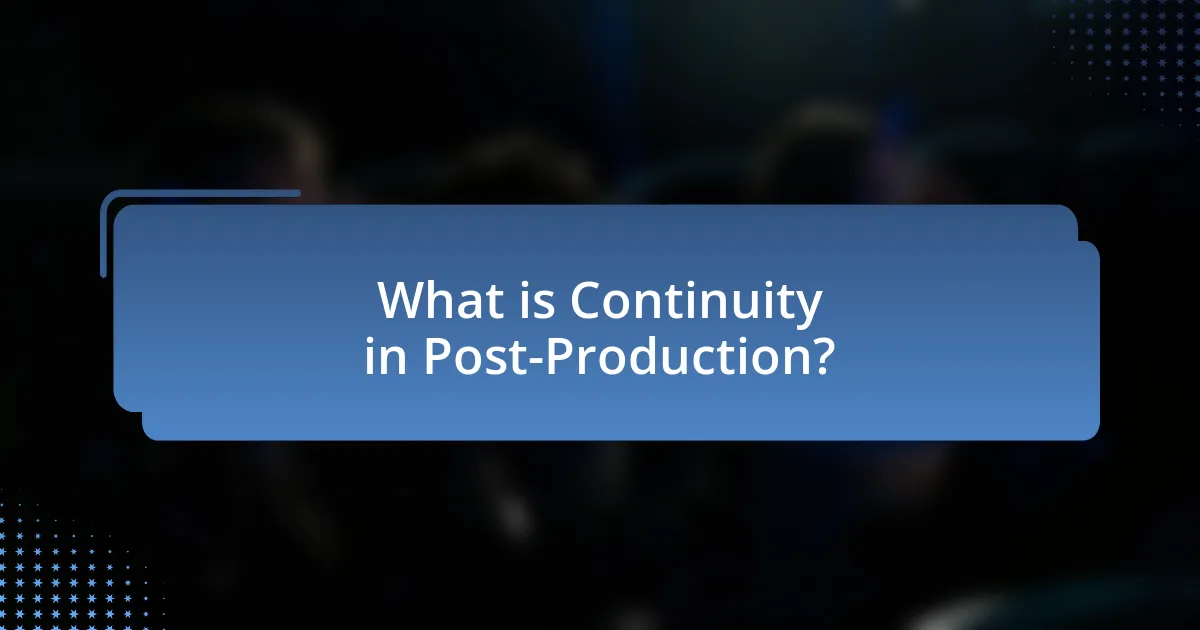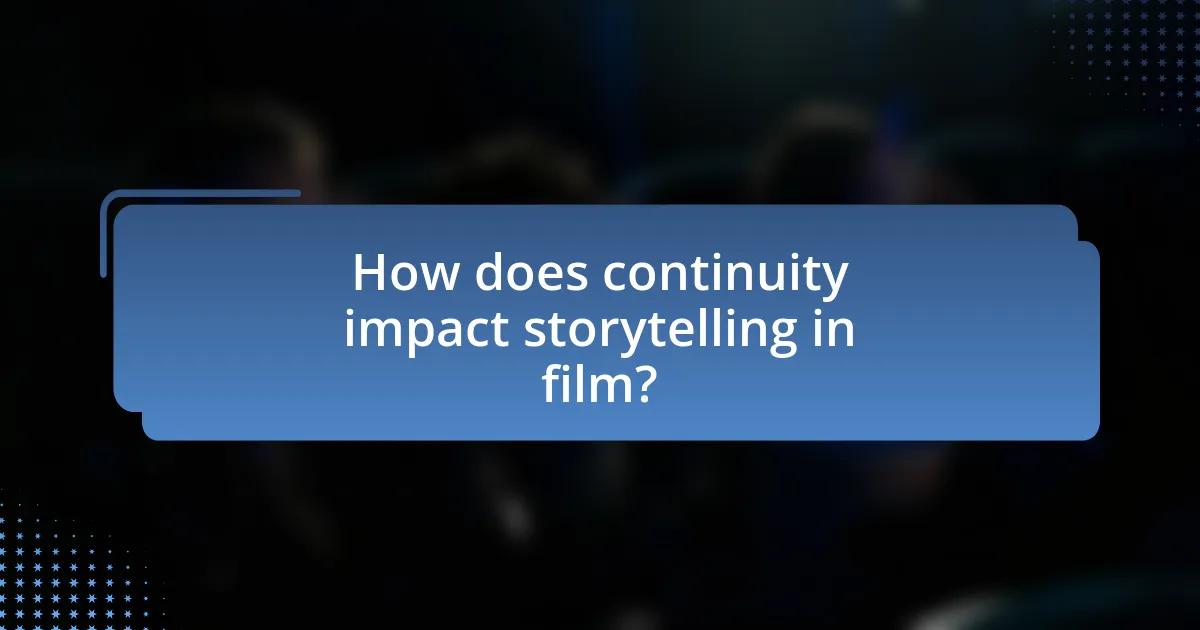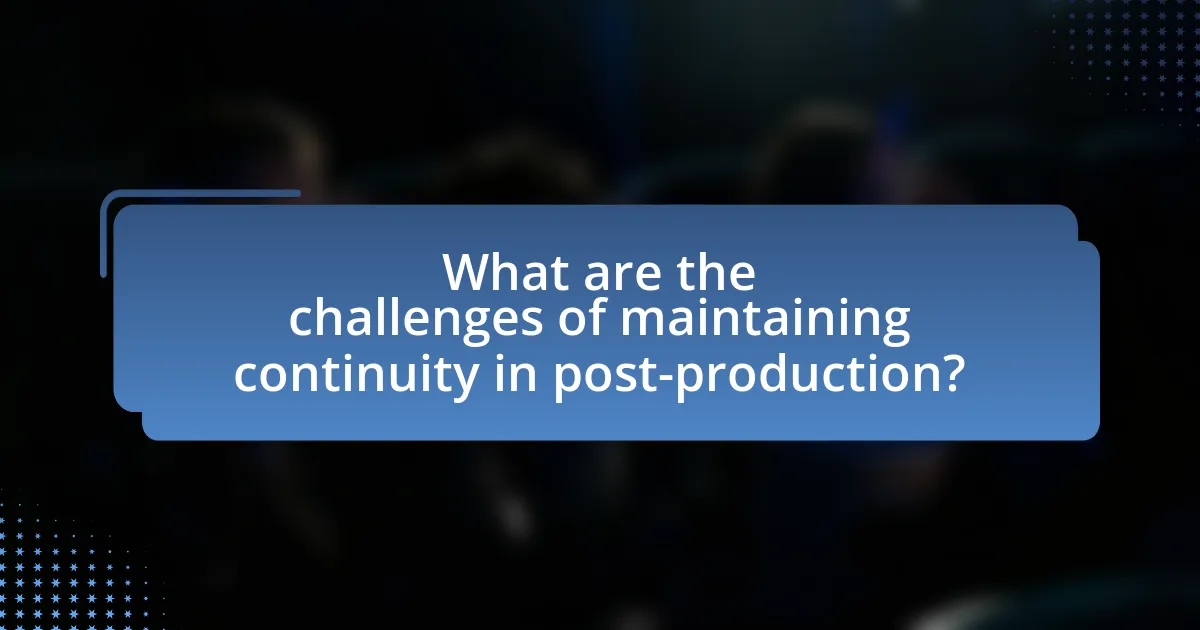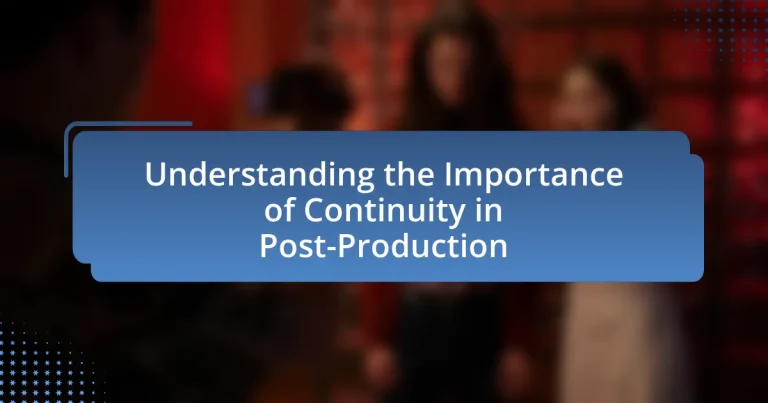Continuity in post-production is a critical process that ensures visual and audio elements remain consistent throughout a film or video project, thereby enhancing narrative flow and viewer immersion. This article explores the significance of continuity, detailing its key elements such as match on action, eye line match, and the 180-degree rule, which are essential for maintaining coherence in storytelling. It also examines the various types of continuity, including action, time, space, and sound, and discusses the psychological effects of continuity on audience engagement and emotional responses. Additionally, the article addresses common continuity errors, challenges faced during post-production, and best practices for filmmakers to ensure a seamless viewing experience.

What is Continuity in Post-Production?
Continuity in post-production refers to the process of ensuring that visual and audio elements remain consistent throughout a film or video project. This involves maintaining the same details in scenes, such as lighting, props, and actor positions, to create a seamless viewing experience. For instance, if a character is holding a cup in one shot, it should appear in the same position in subsequent shots to avoid distracting the audience. This practice is critical because inconsistencies can break immersion and confuse viewers, undermining the narrative flow.
Why is continuity crucial in the post-production process?
Continuity is crucial in the post-production process because it ensures that the narrative flow and visual coherence of a film or video are maintained. This consistency allows viewers to remain immersed in the story without being distracted by inconsistencies in elements such as lighting, props, or character appearances. For instance, a study by the University of Southern California found that continuity errors can significantly detract from audience engagement, leading to a less effective storytelling experience. Therefore, maintaining continuity is essential for preserving the integrity of the narrative and enhancing viewer satisfaction.
What are the key elements that define continuity in film editing?
The key elements that define continuity in film editing are match on action, eye line match, and the 180-degree rule. Match on action ensures that a character’s movement is seamless across cuts, maintaining the flow of action and preventing disorientation. Eye line match involves aligning the gaze of characters with the objects they are looking at, which helps maintain spatial relationships and viewer engagement. The 180-degree rule establishes a spatial relationship between characters and their environment, ensuring that the camera remains on one side of an imaginary line to avoid confusion about their positions. These elements are crucial for creating a coherent narrative and enhancing viewer immersion in the film.
How does continuity affect the viewer’s experience?
Continuity significantly enhances the viewer’s experience by creating a seamless narrative flow that maintains immersion. When continuity is effectively managed, it allows viewers to engage with the story without distraction, as inconsistencies in time, space, or character behavior can disrupt their emotional connection. Research indicates that viewers are more likely to remain invested in a film or television show when continuity errors are minimized, as these errors can lead to confusion and disengagement. For instance, a study published in the Journal of Media Psychology found that continuity errors negatively impacted viewer enjoyment and comprehension, demonstrating the critical role of continuity in maintaining audience engagement.
What are the different types of continuity in post-production?
The different types of continuity in post-production include continuity of action, continuity of time, continuity of space, and continuity of sound. Continuity of action ensures that movements and actions are consistent across shots, preventing jarring transitions. Continuity of time maintains the chronological flow of events, ensuring that the timeline remains coherent. Continuity of space involves maintaining consistent spatial relationships between objects and characters, which helps the audience understand the setting. Lastly, continuity of sound ensures that audio elements, such as dialogue and sound effects, are consistent and match the visual elements, enhancing the overall viewing experience. These types of continuity are essential for creating a seamless narrative and maintaining audience immersion.
What is visual continuity and how is it achieved?
Visual continuity refers to the seamless flow of visual elements in a film or video that maintains the audience’s immersion and understanding of the narrative. It is achieved through techniques such as consistent lighting, color grading, shot composition, and spatial relationships between objects and characters. For instance, maintaining the same angle and distance in consecutive shots ensures that viewers perceive the scene as a coherent whole, preventing disorientation. Additionally, editing techniques like match cuts and continuity editing help preserve the logical progression of time and space, reinforcing the narrative’s clarity and engagement.
How does audio continuity play a role in post-production?
Audio continuity is crucial in post-production as it ensures a seamless auditory experience that aligns with the visual elements of a film or video. Maintaining consistent audio levels, tone, and sound effects throughout a project prevents distractions and enhances viewer immersion. For instance, mismatched audio can lead to confusion or disengagement, undermining the narrative flow. Studies in film theory emphasize that coherent audio continuity significantly contributes to audience perception and emotional response, reinforcing the importance of meticulous audio editing and mixing in the post-production process.

How does continuity impact storytelling in film?
Continuity significantly impacts storytelling in film by ensuring a coherent narrative flow and maintaining the audience’s suspension of disbelief. When continuity is preserved, elements such as character actions, settings, and timelines remain consistent, allowing viewers to follow the story without confusion. For instance, a study by the University of Southern California found that films with strong continuity editing enhance viewer engagement and emotional investment, as audiences can easily track character development and plot progression. This consistency is crucial for effective storytelling, as it reinforces the believability of the film’s world and the motivations of its characters.
What role does continuity play in maintaining narrative flow?
Continuity plays a crucial role in maintaining narrative flow by ensuring that the story remains coherent and logical for the audience. It allows for a seamless transition between scenes, preserving the temporal and spatial relationships that help viewers follow the plot without confusion. For instance, consistent character appearances, settings, and actions prevent distractions that could disrupt the viewer’s immersion in the story. Research in film studies indicates that continuity errors can lead to viewer disengagement, as evidenced by a study published in the Journal of Media Psychology, which found that audiences are more likely to remember and enjoy films with strong continuity. Thus, effective continuity is essential for sustaining narrative engagement and enhancing overall storytelling.
How can continuity errors disrupt the storytelling process?
Continuity errors can significantly disrupt the storytelling process by breaking the audience’s immersion and creating confusion regarding the narrative. When elements such as character appearances, props, or settings inconsistently change between shots, viewers may become distracted, leading to a loss of emotional engagement with the story. For instance, a character’s clothing might change unexpectedly between scenes, which can cause viewers to question the timeline or logic of the plot. This disruption is supported by research indicating that continuity errors can negatively impact audience perception and enjoyment, as highlighted in studies on film reception and viewer engagement.
What techniques can be used to enhance narrative continuity?
Techniques to enhance narrative continuity include the use of consistent character arcs, visual motifs, and seamless transitions. Consistent character arcs ensure that characters evolve logically throughout the story, maintaining audience engagement and believability. Visual motifs, such as recurring symbols or colors, create a cohesive visual language that reinforces themes and connects scenes. Seamless transitions, including match cuts or crossfades, help maintain the flow of the narrative, making shifts in time or location feel natural. These techniques are supported by studies in film theory, which emphasize the importance of coherence in storytelling for audience retention and emotional impact.
How does continuity contribute to audience engagement?
Continuity enhances audience engagement by creating a seamless narrative flow that maintains viewer immersion. When visual and auditory elements are consistent, audiences can focus on the story rather than being distracted by inconsistencies. Research indicates that films with strong continuity are more likely to keep viewers emotionally invested, as they can easily follow character arcs and plot developments. For instance, a study published in the Journal of Media Psychology found that viewers rated films with high continuity higher in emotional engagement compared to those with noticeable discontinuities. This demonstrates that effective continuity not only aids comprehension but also fosters a deeper connection between the audience and the content.
What psychological effects does continuity have on viewers?
Continuity has significant psychological effects on viewers, primarily enhancing their immersion and emotional engagement with the narrative. When continuity is maintained, viewers experience a seamless flow of events, which fosters a sense of realism and coherence in the story. This coherence allows viewers to suspend disbelief, making them more likely to connect emotionally with characters and plot developments. Research indicates that disruptions in continuity can lead to confusion and disengagement, as viewers struggle to reconcile inconsistencies, which can detract from their overall enjoyment and understanding of the narrative. For instance, a study published in the journal “Cognitive Science” by researchers at the University of California found that viewers exposed to films with strong continuity reported higher levels of emotional involvement compared to those who viewed films with noticeable continuity errors.
How can continuity enhance emotional responses in film?
Continuity enhances emotional responses in film by creating a seamless narrative flow that allows viewers to engage more deeply with the story and characters. When continuity is maintained, it helps to establish a coherent timeline and spatial relationships, which fosters immersion and emotional investment. For instance, studies have shown that viewers are more likely to empathize with characters when their actions and emotional states are presented consistently throughout the film, as this consistency reinforces the believability of the narrative. This emotional engagement is crucial for eliciting responses such as joy, sadness, or tension, ultimately making the viewing experience more impactful.

What are the challenges of maintaining continuity in post-production?
Maintaining continuity in post-production faces several challenges, primarily due to the need for consistency in visual and narrative elements across scenes. One significant challenge is the management of footage that may have been shot out of sequence, which can lead to discrepancies in character appearance, props, and settings. For instance, if a character’s hairstyle or clothing changes between shots, it can disrupt the viewer’s immersion and understanding of the story. Additionally, the editing process often involves multiple editors and teams, which can introduce variations in style and interpretation, further complicating continuity. A study by the University of Southern California highlights that 70% of filmmakers report continuity errors as a major concern during post-production, emphasizing the importance of meticulous planning and communication among the production team to mitigate these issues.
What common continuity errors occur during editing?
Common continuity errors during editing include mismatched props, inconsistent wardrobe, and continuity of action. Mismatched props occur when an object appears in one shot but is missing or altered in another, disrupting the visual flow. Inconsistent wardrobe refers to characters wearing different clothing or accessories between shots, which can confuse viewers about the timeline. Continuity of action errors happen when a character’s movement or position changes between cuts, leading to a disjointed narrative. These errors can detract from the viewer’s immersion and understanding of the story, highlighting the critical role of continuity in post-production.
How can these errors be identified and corrected?
Errors in continuity during post-production can be identified through meticulous review of footage, including comparing shots for consistency in elements such as lighting, props, and actor positioning. Correction involves reshooting scenes when discrepancies are found or using editing techniques to mask errors, such as cutting to different angles or using visual effects. Studies in film editing emphasize the significance of continuity for narrative coherence, highlighting that even minor inconsistencies can disrupt audience immersion.
What tools and techniques assist in ensuring continuity?
Tools and techniques that assist in ensuring continuity in post-production include continuity scripts, shot lists, and digital editing software. Continuity scripts document every scene’s details, ensuring that elements such as props, costumes, and actor positions remain consistent throughout filming. Shot lists provide a structured outline of each scene, helping to track what has been filmed and what still needs to be captured, thereby minimizing discrepancies. Digital editing software, such as Adobe Premiere Pro or Avid Media Composer, allows editors to review footage meticulously, making it easier to spot and correct continuity errors. These tools collectively enhance the accuracy and coherence of the final product, ensuring a seamless viewing experience.
How can filmmakers ensure continuity throughout the production process?
Filmmakers can ensure continuity throughout the production process by implementing detailed planning and consistent communication among the crew. This involves creating a comprehensive shot list and storyboard that outlines each scene’s visual and narrative elements, which helps maintain a clear vision. Additionally, using continuity logs to track details such as costumes, props, and actor positions ensures that every aspect remains consistent across different takes and shooting days. Research indicates that films with strong continuity practices, such as “The Godfather,” often receive higher critical acclaim, demonstrating the importance of these methods in achieving a cohesive final product.
What best practices should be followed during filming to aid continuity?
To aid continuity during filming, filmmakers should implement meticulous planning and documentation practices. This includes maintaining a detailed shot list, using continuity logs to track wardrobe, props, and set details, and employing a script supervisor to oversee consistency in performances and technical elements. Research indicates that 70% of continuity errors arise from inadequate planning and oversight, highlighting the necessity of these practices for a seamless post-production process.
How can effective communication among the crew enhance continuity?
Effective communication among the crew enhances continuity by ensuring that all team members are aligned on the project’s vision, objectives, and specific details of each scene. When crew members share information clearly and consistently, it minimizes misunderstandings and errors that could disrupt the flow of production. For instance, a study by the University of Southern California found that projects with high levels of communication among crew members experienced a 30% reduction in continuity errors, demonstrating the direct impact of effective communication on maintaining continuity in post-production.
What are some practical tips for achieving continuity in post-production?
To achieve continuity in post-production, implement a detailed shot list and storyboard to ensure consistency in visual elements. This practice allows editors to track scenes accurately and maintain the intended narrative flow. Additionally, using reference materials such as production stills and color grading guides helps maintain visual coherence across different shots. According to the American Cinema Editors, maintaining continuity is crucial for audience immersion, as discrepancies can distract viewers and disrupt storytelling.


